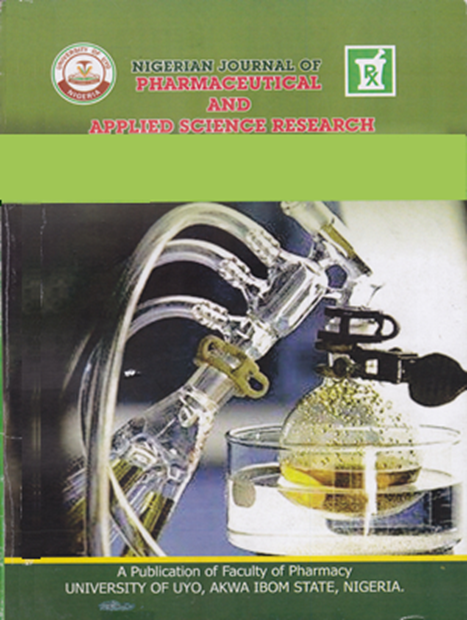Chemical analysis of Agama agama Linnaeus, 1758. (Agamidae) excreta: Emerging trends in substance abuse in Nigeria
Contenu principal de l'article
Résumé
Background: Absence of data on the chemical composition of the excreta of Agama agama, a novel substance widely abused by young people in Nigeria prompted an investigation into the excreta of A. agama in order to identify and assess its psychoactive and toxic contents, so as to make informed decisions on its use.
Methods: Fresh excreta of A. agama were collected from uncompleted buildings in the Federal University, Otuoke, Bayelsa state. Collected samples were sun dried for ten days, pulverized and then processed for analysis. The chemical constituents of the concentrated extracts of A. agama excreta were determined with a Gas Chromatography-Mass Spectrometry (GC-MS) machine.
Results: The result revealed seventeen compounds along with their nomenclature, chemical formula, structure, molecular weight, retention time and peak area. The most abundant constituent was 9,12-Octadecadienoic acid (17.53%). The constituent with the highest retention time (20.417mins) was methyl-16-hydroxyhexadecanoate while the constituent with the highest molecular weight (334 Da) was cyclopropaneoctanoic acid. Psychoactive compounds identified among the constituents were nonanoic acid, n-hexadecanoic acid and 8-methyl-6-nonenamide while the toxic chemicals identified among the constituents were 1-eicosene, nonanoic acid, n-hexadecanoic acid, 8-methyl-6-nonenamide, 9,12-octadecadienoic acid, hexadecanoic acid, 11-octadecanoic acid, 15-hydroxypentadecanoic acid and methyl stearate.
Conclusion: The toxic compounds identified in A. agama excreta pose significant health risks to individuals who consume it. This study provides empirical evidence to discourage the unregulated use A. agama excreta for its psychoactive effects. Hence, there is need for policy formulations and public awareness measures to educate, sensitize and cascade these to young people.
Téléchargements
Renseignements sur l'article

Cette œuvre est sous licence Creative Commons Attribution - Pas d'Utilisation Commerciale - Pas de Modification 4.0 International.
Références
. Rehms, J., Room, R. & Monteiro, M. (2003). Alcohol as a risk factor for global burden of disease. European Addiction Research, (9):157-164
. Hamisu, M., Ahmad, O.T., & Lim, L.H., (2014). “Adolescents and drugs abuse”. Nigeria Journal ofBiology, Agriculture and Healthcare, 40(1):5-9
. Aich, T., Saha, I., Ram, D., Ranjan, S., & Subedi, S. (2015). A comparative study on 136 opioid abusers in India and Nepal”. Journal of Psychiatrists’ Association of Nepal, (2)11–17.
. Siegel, A. & Ronald, K. (2015). Intoxication: the universal Drive for Minding- Altering Substances. Park street press, 60:99-108
. Samorini, G. (2017). The Natural world & the instinct to alter consciousness. Animals and psychedelics, 89: 986-999
. Bauman, A. & Phongsaven, P. (2015). Epidemiology of substance use in adolescence, prevalence, trends and policy implications, Drug alcohol depend park street press, 55: 187-207
. Anochie, C., Nkanginieme, K.E., Eke, F. & Alikor, E.A. (2015). Drug abuse among secondary school students in port metropolis Niger. Journal of medicine, (8): 17-23
. Moronkola, O.A. (2003). Essays on issues in health. Royal people Nigeria limited, Ibadan, 66–70.
. Burton, M. & Burton, R. (2002). International Wildlife Encyclopedia. Illustrated edition, Marshall Cavendish publishers, 30-40.
. Varghese, S.T., Balhara, Y. & Mondal, A. (2006). Unconventional substances of abuse: scorpions and lizards. Journal Postgraduate Medicine,52: 325-326
. Garg, M., Sidhu, B.S. & Raj, R. (2014). Addiction to lizard. Indian journal psychiatry 56(2): 244-249
. Ikimi, C.G. & Addy, P.S. (2024). Effects of a mixture of methylated spirit and carbonated cola drink (a novel substance abused by Nigerian youths) on the lipid profile of Wistar rats. International journal of health and pharmaceutical research (international institute of research and academic development), Vol. 9 (3): 83 – 92.
. Agoro, E.S., Ikimi, C.G. and Edidiong, T. (2021). The use of vitreous renal chemistries in the discrimination of postmortem fresh water drowning. Toxicology research and application, Vol. 5: 1-6.
. Ezenwa-Ohaeto, N. (2013). Sociolinguistic import of name-clipping among Omambala cultural zone in Anambra State. Creative Artist: A Journal of Theatre and Media Studies 7(2): 111 – 128.
. Sparkman, O.D., Penton, Z.E. & Kitson, F.G. (2011). Gas chromatography and mass spectrometry: a practical guide, second edition, Academic press publishers,15-20.
. Fry, B.G., Vidal, N., Norman, J.A., Vonk, F.J., Scheib, H., Ramjan, S.F., Kuruppu, S., Hedges, S.B., Richardson, M.K., Hodgson, W.C., Ignjatovic, V., Summerhayes, R. & Kochva, E. (2006). Early evolution of the venom system in lizards and snakes, Nature, 439: 584–588.
. Saleem, U., Khalid, S., Zaib, S., Anwa, F., Ahmad, B., Ullah, I., Zeb, A. & Ayaz, M. (2020). Phytochemical analysis and wound healing studies on ethnomedicinally important plant Malva neglecta Wallr. Journal of Ethnopharmacology. 2489(8):112401
. Chang, P., Terbach, N., Plant, N., Chen, P.E., Walker, M.C., & Williams, R.S. (2013). Seizure control by ketogenic diet-associated medium chain fatty acids”. Neuropharmacology, 69: 105-114
. Global Harmonized System (2022). Safety Data Sheet, OSHA HCS.
. Nelson, L.S., Howland, M. A., Lewin, N.A., Smith, S.W., Goldfrank, L.R. & Hoffman, R.S. (2019) Goldfrank’s toxicologic emergencies, 11th edition, McGraw-Hill Education: 978-999
. Sayers, E. (2005) An Entrez Database of Small Molecules. NLM Tech Bull. PubChem:(342): e2.
. National Toxicology Program (NTP) (1992). NTP technical report on toxicity studies of castor oil (CAS No. 8001-79-4
. Wang, J., Wu, F., Liang, Y. & Wang, M. (2010). Process optimization for the enrichment of alpha-linolenic acid from silkworm pupal oil using response surface methodology. African journal of biotechnology, Vol. 9(20): 2956 – 2964.
. Ikimi, C.G., Adias, T.C. and Agoro, E.S. (2024). Effects of a mixture of methylated spirit and carbonated cola drink (a novel substance abused by Nigerian youths) on kidney function and haematological parameters in Wistar rats. Otuoke Journal of Medical Laboratory Science, Vol. 1 (1): 119 – 128.
. Katshu, M.Z.U.H., Dubey, I., Khess, C.R.J. & Sarkhel, S. (2011). Snake bite as a novel form of substance abuse: personality profiles and cultural perspectives, Substance Abuse - Official Publication of the Association for Medical Education and Research in Substance Abuse, 32:4
. Okpataku, C.I. (2020). Patterns of psychoactive substance use in Nigeria: A systematic review of literature. West African Journal of Medicine, 37(4): 259 – 270.


